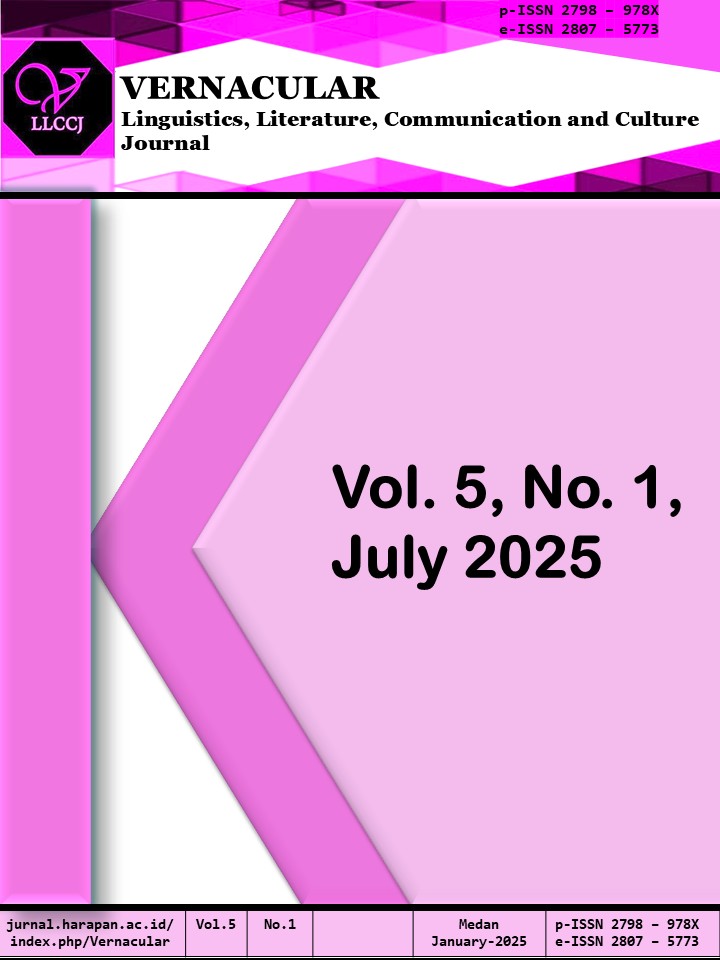THE ROLE OF MOTIVATION AND DIGITAL TECHNOLOGY IN ENHANCING MANDARIN LANGUAGE PROFICIENCY AMONG STUDENTS OF THE MANDARIN LANGUAGE FOR BUSINESS AND PROFESSIONAL COMMUNICATION PROGRAM AT UNPRI
DOI:
https://doi.org/10.35447/vernacular.v5i1.1179Keywords:
Motivation, Digital Technology, Mandarin Language ProficiencyAbstract
The aim of this study is to examine the extent to which motivation and digital technology influence the improvement of Mandarin language proficiency among students in the Mandarin Language for Business and Professional Communication Study Program at Universitas Prima Indonesia. Specifically, this research analyzes the effect of motivation on language mastery, the role of technology in the learning process, and the combined impact of both factors on learning outcomes. A quantitative descriptive approach was employed, with data collected through a questionnaire as the main instrument, completed by 37 respondents. The findings indicate that motivation has a significant impact on Mandarin language proficiency (significance value < 0.05; t-value = 4.390 > t-table = 2.032). In contrast, the individual use of digital technology does not have a significant effect (significance = 0.983 > 0.05). However, the integration of motivation and technology demonstrates a significant simultaneous effect (significance < 0.05; F-value = 76.279 > F-table = 3.27). These findings emphasize the importance of motivation in language learning and highlight the potential of technology when appropriately applied. Therefore, educational institutions are encouraged to develop learning approaches that combine these two aspects to enhance Mandarin language mastery.
Downloads
References
Deci, E. L., & Ryan, R. M. 2017. Self-Determination Theory: Basic Psychological Needs in Motivation, Development, and Wellness. New York: Guilford Publications.
Godwin-Jones, R. 2011. “Emerging Technologies: Mobile Apps for Language Learning.” Language Learning & Technology, 15(2): 2–11.
Herzberg, F. 1959. The Motivation to Work. New York: John Wiley & Sons.
Lin, H., Chen, X., & Zhao, M. 2023. “Integrating Motivation and Technology in Language Learning: A Case Study.” International Journal of Language Learning and Technology, 28(1): 55–72.
Liu, Y., & Huang, X. 2020. “The Impact of Motivation on Second Language Acquisition.” Applied Linguistics Research, 45(2): 98–112.
Locke, E. A. 1968. “Toward a Theory of Task Motivation and Incentives.” Organizational Behavior and Human Performance, 3(2): 157–189.
Mutmainnah, S., Rahman, A., & Suryani, I. 2021. “Faktor-Faktor yang Mempengaruhi Motivasi Belajar Bahasa Asing pada Mahasiswa.” Jurnal Pendidikan Bahasa dan Sastra, 12(2): 78–92.
Nduru, Nike Ardila & Rudiansyah. 2022. “Pemanfaatan Media Digital dalam Pembelajaran Bahasa Mandarin.” Jurnal Teknologi Pendidikan, 10(1): 112–125.
Richards, J. C., & Rodgers, T. S. 2014. Approaches and Methods in Language Teaching. 3rd ed. Cambridge: Cambridge University Press.
Situmeang, R. 2024. Kurikulum Program Studi Bahasa Mandarin Bisnis dan Profesional: Tantangan dan Peluang. Medan: Universitas Prima Indonesia Press.
Stockwell, G. 2013. Technology and Motivation in English-Language Teaching and Learning. London: Routledge.
Sugiyono. 2019. Statistika untuk Penelitian. Bandung: Alfabeta.
Sugiyono. 2020. Metode Penelitian Kuantitatif, Kualitatif, dan R&D. Bandung: Alfabeta.
Sugiyono. 2022. Metode Penelitian Pendidikan: Pendekatan Kuantitatif, Kualitatif, dan R&D. Bandung: Alfabeta.
Sujarweni, V. Wiratna. 2015. Metodologi Penelitian: Lengkap, Praktis, dan Mudah Dipahami. Yogyakarta: Pustaka Baru Press.
Usman, M., & Burhanuddin, A. 2021. “Pengaruh Lingkungan Belajar terhadap Motivasi Mahasiswa dalam Mempelajari Bahasa Asing.” Jurnal Psikologi Pendidikan, 8(3): 45–58.
Vroom, V. H. 1964. Work and Motivation. New York: Wiley.
Wang, R., & Wang, L. 2021. “Digital Tools in Language Learning: Opportunities and Challenges.” Technology in Language Education, 19(3): 220–235.
Wen, X. 2011. “Chinese Language Learning Motivation: A Comparative Study of Heritage and Non-Heritage Learners.” Heritage Language Journal, 8(3): 41–66.
Zhang, S., Li, J., & Peng, W. 2022. “The Effectiveness of AI-assisted Language Learning: A Meta-analysis.” Journal of Computer-assisted Language Learning, 30(2): 145–165.
Downloads
Published
How to Cite
Issue
Section
License
Copyright (c) 2025 Tetti Manalu

This work is licensed under a Creative Commons Attribution-NonCommercial-ShareAlike 4.0 International License.








.png)

















